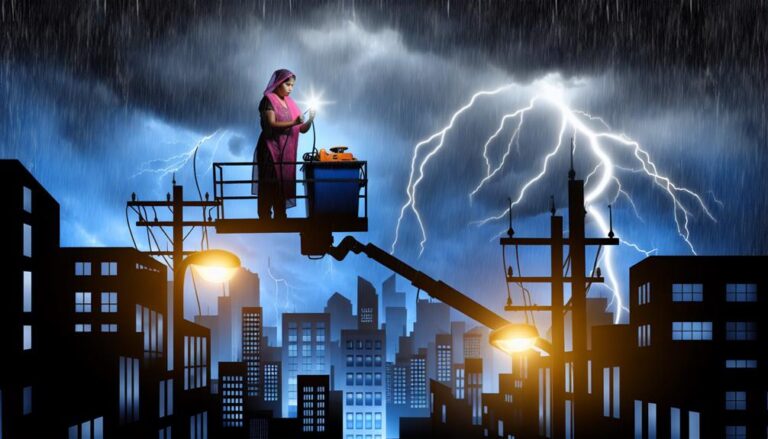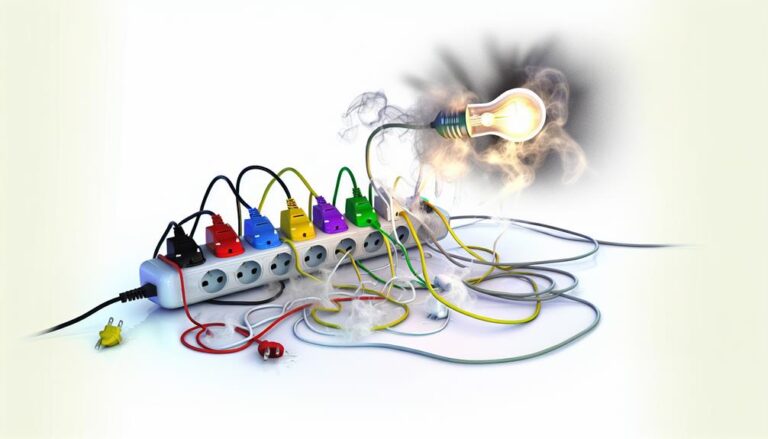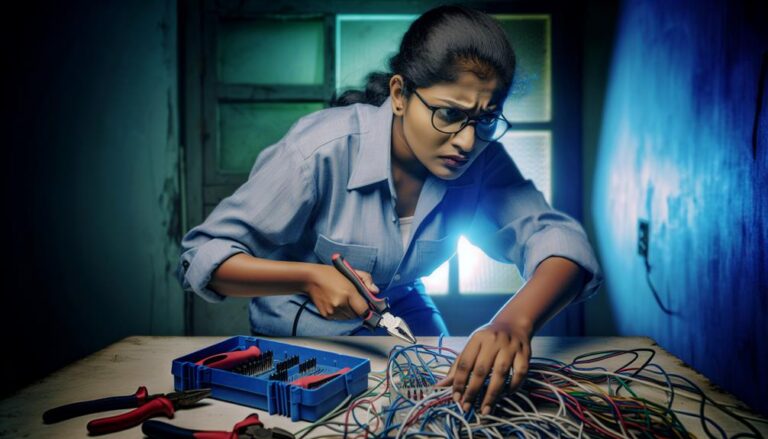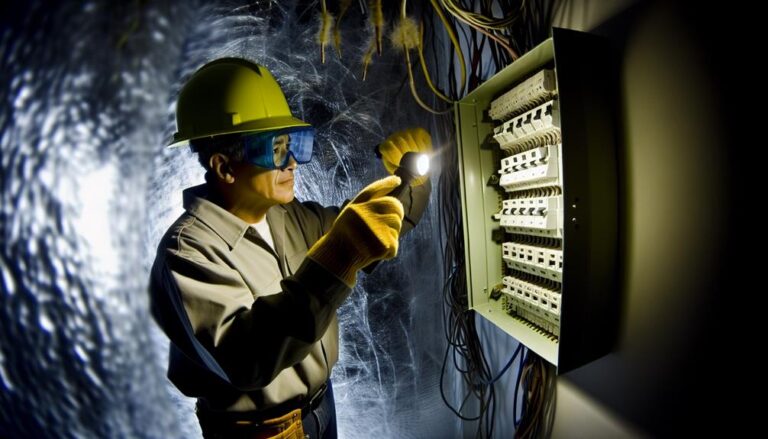Safety Protocols for Handling Electrical Emergencies
Imagine you’re walking through a dense forest, surrounded by towering trees. Suddenly, you notice a spark of electricity dancing on a nearby branch, crackling with a dangerous energy. Just like in that forest, electrical emergencies can strike at any moment, leaving you in a precarious situation.
But fear not, because in this discussion, we will uncover the essential safety protocols that will empower you to handle these emergencies with confidence and precision.
So, let’s explore the steps you need to take when faced with electrical hazards, the immediate actions to ensure your safety, and the precautions for handling live wires and electrical fires.
By the end, you’ll be equipped to navigate through these challenges and emerge unscathed.
Key Takeaways
- Inspect electrical equipment and cords for damage to prevent potential hazards.
- Take immediate actions during an electrical emergency by assessing the severity, disconnecting power, and calling emergency services.
- Follow safety precautions when handling live wires, such as wearing PPE and using insulated tools.
- Safely address electrical fires by assessing the severity, cutting off power, and using the appropriate fire extinguisher.
Identifying Potential Electrical Hazards
To effectively ensure electrical safety, it’s crucial to accurately identify potential hazards in your surroundings. Being aware of these hazards can help prevent accidents and safeguard your freedom to live without fear of electrical emergencies.
Start by inspecting your electrical equipment and cords for any signs of damage, such as frayed wires or exposed insulation. These issues can lead to electrical shocks or even fires. Additionally, make sure to keep flammable materials away from electrical outlets and appliances to reduce the risk of ignition.
Next, pay attention to the placement of your electrical devices. Avoid overcrowding outlets with multiple plugs and adapters, as this can overload the circuit and cause overheating. Be mindful of the wattage and capacity limits of your electrical system to prevent electrical failures.
Furthermore, take note of any potential sources of water near electrical equipment. Water is a conductor of electricity and can lead to fatal shocks. Keep electrical devices away from wet areas, and install ground fault circuit interrupters (GFCIs) in areas where water is present, such as bathrooms and kitchens.
Lastly, if you notice any unusual smells, sounds, or sparks coming from your electrical equipment, immediately turn off the power and seek professional help. These signs could indicate a serious electrical problem that requires immediate attention.
Immediate Actions to Take During an Electrical Emergency
In the event of an electrical emergency, it’s crucial to take immediate action to ensure your safety and minimize the risk of further damage. Here are the steps you should follow:
- Assess the Situation
- Stay calm and quickly evaluate the severity of the emergency.
- Identify any potential dangers, such as exposed wires or smoke.
- Ensure Personal Safety
- If someone is in contact with the electrical source, don’t touch them directly. Instead, try to disconnect the power supply or use a non-conductive object to separate them from the source.
- If the emergency involves water and electricity, avoid contact with the water and electrical equipment to prevent electrocution.
- Call for Help
- Dial emergency services to report the situation and provide them with accurate details about the emergency.
- Notify any relevant authorities, such as building management or utility companies, if necessary.
- Evacuate the Area
- If the emergency poses an immediate threat, evacuate the premises and ensure everyone is out of harm’s way.
- Keep a safe distance from the affected area until professionals arrive to assess and address the situation.
Safety Precautions for Handling Live Wires
When handling live wires, it is imperative to take strict safety precautions to prevent accidents and ensure personal well-being. Live wires carry a high amount of electrical current, which poses a serious risk of electric shock or even electrocution. To protect yourself and others, follow these safety measures:
| Safety Precautions | Description |
|---|---|
| Wear Personal Protective Equipment (PPE) | Always wear insulated gloves, safety goggles, and rubber-soled shoes to protect against electric shock. |
| Turn off Power Source | Before working on live wires, make sure to turn off the power source at the circuit breaker or fuse box. |
| Use Insulated Tools | Use tools with insulated handles to minimize the risk of electrical shock. |
| Maintain a Safe Distance | Keep a safe distance from live wires and any conductive materials to prevent accidental contact. |
Steps to Safely Address Electrical Fires
What steps can you take to safely address electrical fires?
When faced with an electrical fire, it’s crucial to act quickly and effectively to minimize damage and ensure the safety of yourself and others. To address electrical fires safely, follow these steps:
- Step 1: Assess the situation
- Evaluate the severity of the fire and determine if it can be handled using a fire extinguisher or if evacuation is necessary.
- Identify potential hazards, such as live wires or smoke, and take appropriate precautions.
- Step 2: Cut off the power
- Locate the main electrical panel and switch off the power supply to the affected area.
- If it’s safe to do so, unplug any electrical devices that may be contributing to the fire.
- Step 3: Smother the fire
- Use a fire extinguisher specifically designed for electrical fires, such as a Class C extinguisher, to smother the flames.
- Aim at the base of the fire and sweep the extinguisher from side to side until the flames are extinguished.
- Step 4: Evacuate and call for help
- If the fire can’t be contained or if it spreads rapidly, evacuate the area immediately.
- Dial emergency services and provide accurate information about the location and nature of the fire.
Ensuring Personal Safety During Electrical Emergencies
To ensure your personal safety during electrical emergencies, it’s imperative to follow proper safety protocols and take immediate action.
When faced with an electrical emergency, your first instinct may be to panic or freeze, but it’s crucial to remain calm and focused. The most important step you can take is to cut off the power supply to the affected area.
Locate the main electrical panel and switch off the circuit breaker or remove the fuse connected to the affected area. This will prevent further electrical hazards and potential fires.
If someone has been injured due to electric shock, don’t touch them directly. Instead, use a non-conductive object like a wooden broom or a dry cloth to separate them from the electrical source. It’s also essential to call for emergency medical assistance immediately.
Avoid using water to extinguish electrical fires, as it can conduct electricity and worsen the situation. Instead, use a fire extinguisher specifically designed for electrical fires or a fire blanket to smother the flames.





